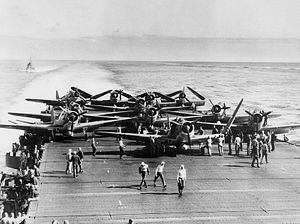This week marks the 75th anniversary of the Battle of Midway, a decisive turning point for the Allied effort in the Pacific theater of the Second World War. The U.S. Navy, led by Admirals Chester Nimitz, Frank Jack Fletcher, and Raymond A. Spruance trounced the Imperial Japanese Navy after 3 days of battle, yielding the first major inflection point in the eastern war after Japan’s surprise attack on Pearl Harbor some six months earlier.
The American victory at Midway is particularly memorable for how miraculous it seemed at the time. In the lead-up to the battle, the Imperial Japanese Navy (IJN) had seen remarkable success in Indochina, the Dutch East Indies, and Malaya, defeating the Royal Navy and making major inroads into Southeast Asia and the Indian Ocean Region. The IJN had additionally annihilated major Dutch and Australian naval units and even sank the U.S. aircraft carrier USS Lexington at the Battle of the Coral Sea.
The perception of the IJN in the lead-up to Midway was one of a near-unstoppable force. The United States effectively held fast in the months after the strike on Pearl Harbor as U.S. industrial shipbuilding capacity was diverted to repairing and servicing the bulk of American battleships at Pearl Harbor. While the attack on Pearl Harbor hindered the U.S. Navy well into the early months of 1942, the U.S. Navy Pacific Fleet’s carriers remained mostly operational.
Midway, a small 2.4 square mile atoll, is named for its rough position in the middle of the Pacific Ocean — the midway point between America’s Pacific coast and the Ryukyu chain. The IJN, convinced of its superiority and seeking to draw out and sink the remainder of the U.S. carrier fleet, saw the position there as an appealing target — an opportunity to lure the U.S. Navy out to defend a strategically vital position that, if taken, could give the IJN a launch pad for missions interdicting trans-Pacific shipping.
In the lead-up to the fateful battle, the IJN almost certainly would have had the initiative and the element of surprise had it not been for a partial breach of the Japanese Navy’s codes. (The National Security Agency has a succinct retelling of the ruse that led the IJN to voluntarily reveal that a then-codeworded target was, indeed, Midway.)
With the code breached, Nimitz was able to take the initiative against Japan, positioning U.S. carriers advantageously. Moreover, by mid-1942, the post-Pearl Harbor shipbuilding and industrial overdrive had paid dividends, with new heavy cruisers and battleships available for U.S. Navy use. In short, the U.S. Navy laid it all on the line at Midway, where a Japanese victory could have marked a decisive tilt in the eastern theater of the Second World War.
Instead, the American gambit paid off handsomely, leading to an unambiguous victory with the loss of a single carrier, USS Yorktown. The IJN, meanwhile, lost 4 carriers — IJN Akagi, Soryu, Kaga, and Hiru— a heavy cruiser, and some 240 aircraft. Despite the IJN’s early tactical successes in the Pacific theater, the lead-up to Midway demonstrated drastic miscalculation that led to devastating defeat. The aftermath of the battle marked the beginning of a shift in the Pacific theater as American industrial production capacity quickly outgrew Japan, which was unable to attain its pre-Midway naval dominance of the Pacific theater and push back into the reaches of the eastern Pacific.
Today, Midway is recalled not only as one of the high points of the U.S. Navy’s experience in the Second World War, but as one of the greatest battles involving carriers and carrier-aviation of all time. The battle has drawn increased interest in China in recent years, for example, as the People’s Liberation Army-Navy gears up for its own six-carrier force and expects to one day have to fight a war at sea against a similarly well-equipped force.

































